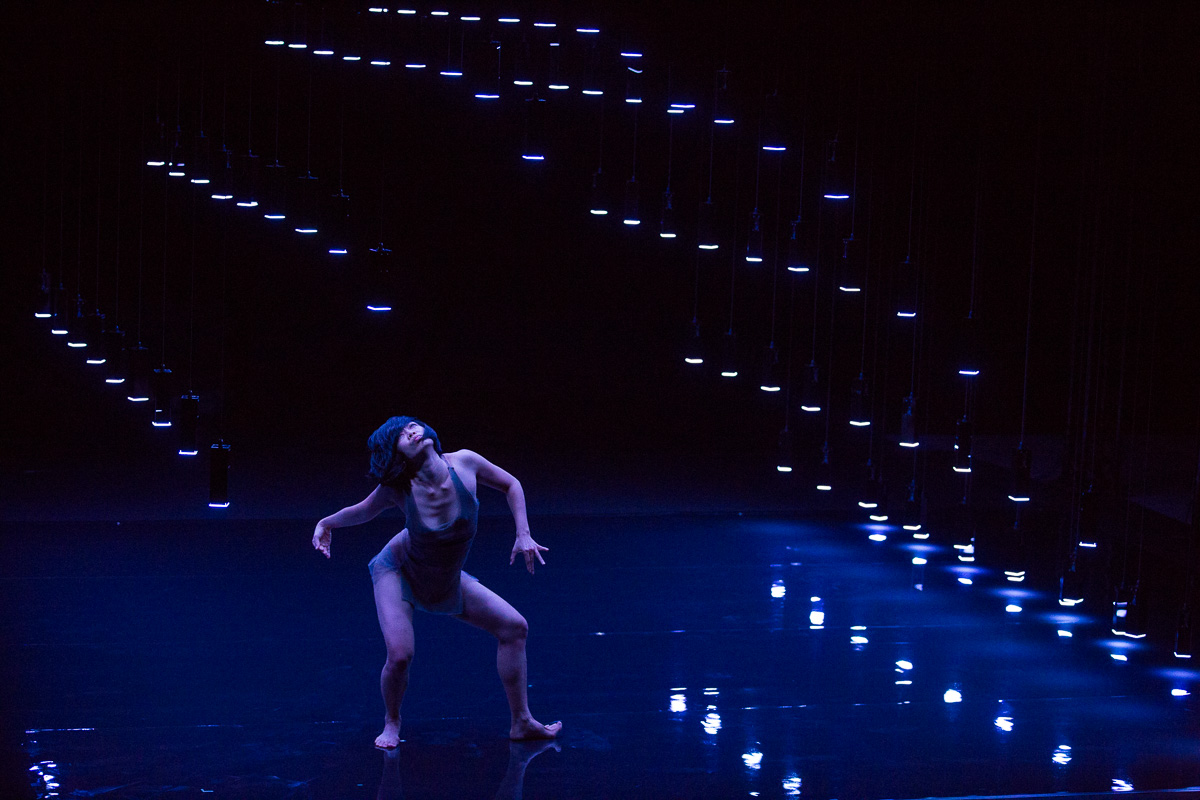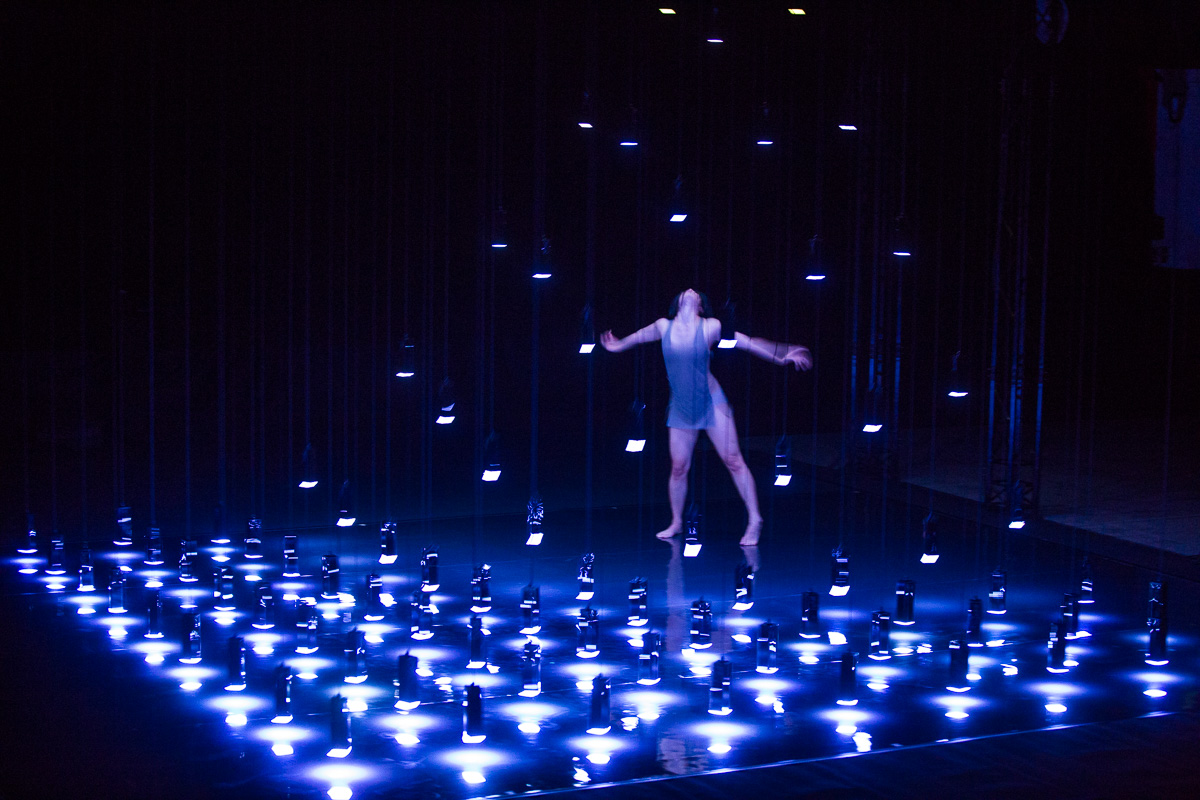《WAVE.微幅》以海浪、波形作為整體意象進行思考,企圖面對自然與人工、真實與虛擬、時間記憶與感官體驗等當代生命的錯綜經驗,從而觀照生存狀態在這些轉變之間的消長關係。舞者蘇文琪的身體作為原始生命力量的主體表現,在聲光機械動力裝置所化現的當代生存空間的各種隱喻中,延展初藝術團隊思考現今面對科技與生命的依存關係。在聲光裝置變化架構出的一個虛幻場景,表演者在光影與聲音中穿梭,在當代世界中必然經歷的虛擬、衰變與消亡裡,引領觀者深入感受生命面對當代世界所展現出的獨特質地 。
一當代舞團 YiLab
2005年成立,團隊負責人為蘇文琪,嘗試從新媒體的思維中,重新探索表演藝術的可能性,延伸當代藝術面對數位時代衝擊所帶來的提問與省思。團隊理念為:一個作品中沒有唯一的中心媒介,每位受邀參與的藝術家都是一個獨立的個體,皆可獨立創作,自由提出各種觀點以深入作品命題之核心。
YiLab was established by the director and choreographer SU Wen-chi in 2005. Su has always strived to explore the potentiality of performing arts in the context of new media, extending her inquiry and reflection about the impact of the digital age on contemporary art. The belief of YiLab is that there is not one particular central medium in one work; each participating artist is an individual, who is capable of independent creation and free to adopt different perspectives to explore the subject of the work.
蘇文琪
張永達
吳季璁
筆古亮也
何理互動設計
葉廷皓、何理互動設計
覃康寧
楊淑雯
斯建華
姚志煒
楊承翰
吳秉聖
陳宜庭、陳盈帆
菉原工作室
富貴列車設計
孫平
吳可雲
黃雯
陳又維、許斌
台北松山文創園區多功能展演廳
關鍵字
- 舞蹈
- LED
- 科技
藝術家談作品
所有萬物都是共同成長。
蘇文琪:「對我來說,最後LED的律動是自然的回歸,那些律動不僅是科技的,也可解釋成自然世界原本就具有的。最終把『共生』的概念放進來,所有萬物都是共同成長。」
評審談作品
蘇文琪像昆蟲和野獸一樣強悍的身體,傳達了人類和科技之間的搏鬥。
入圍理由 Reason for Nomination
神話是舞蹈常見的題材,科技是表演持續的追尋,儘管如此,像《WAVE‧微幅》這樣,從神話的思維表現科技的舞蹈作品卻是少有。於是我們看到,懸空變換的燈光矩陣,近乎神話世界的神秘秩序;下壓的光牆,具現了神話的暴力;而蘇文琪像昆蟲和野獸一樣強悍的身體,傳達了人類和科技之間的搏鬥。難得的是,蘇文琪並沒有落入人工科技和自然肉體的、傳統的二元論,例如當光束越來越閃爍、聲響越來越暴烈,令人預感科技即將帶來毀滅之際,舞者並不是表現肉身的回歸,那是一種混雜著機械動力和儀式舞蹈的身體,又像戰爭機器,又像巫師又像神。印度的濕婆是舞蹈之神,也是毀滅之神,蘇文琪很像濕婆,表現出科技時代的我們如何與毀滅共舞。 提名觀察人 ─ 郭亮廷
Mythology is a common theme in dancing, and technology has been the pursuit of performance. However, it is rare to see a dance performance like 2014 Innovation Series-ReSet in W.A.V.E. by YiLab that presents technology from a mythological point of view. In the performance, we saw the suspended, changing lighting matrix that almost formed the mystic order of a mythological world, the down-pressing wall of light that embodied the violence of mythology, as well as SU Wen-chi’s fierce body that reminded us of insects or beasts, and which delivered the struggle between human beings and technology. It was precious that SU did not fall into the traditional dichotomy between the artificial technology and the natural body. For instance, as the rays of light glistened more violently and the sounds got harsher, it seemed to announce the moment of destruction brought about by technology; yet, instead of returning to the physicality, the dancers assumed a body that amalgamated mechanical power and ritualistic dancing, which reminded us of a war machine as well as a shaman or a god. The Hindu deity, Shiva, is both the god of dance and the god of destruction. In a way, SU was like Shiva showing the way we have danced with destruction in the technological era. Nominator: KUO Liang-Ting






